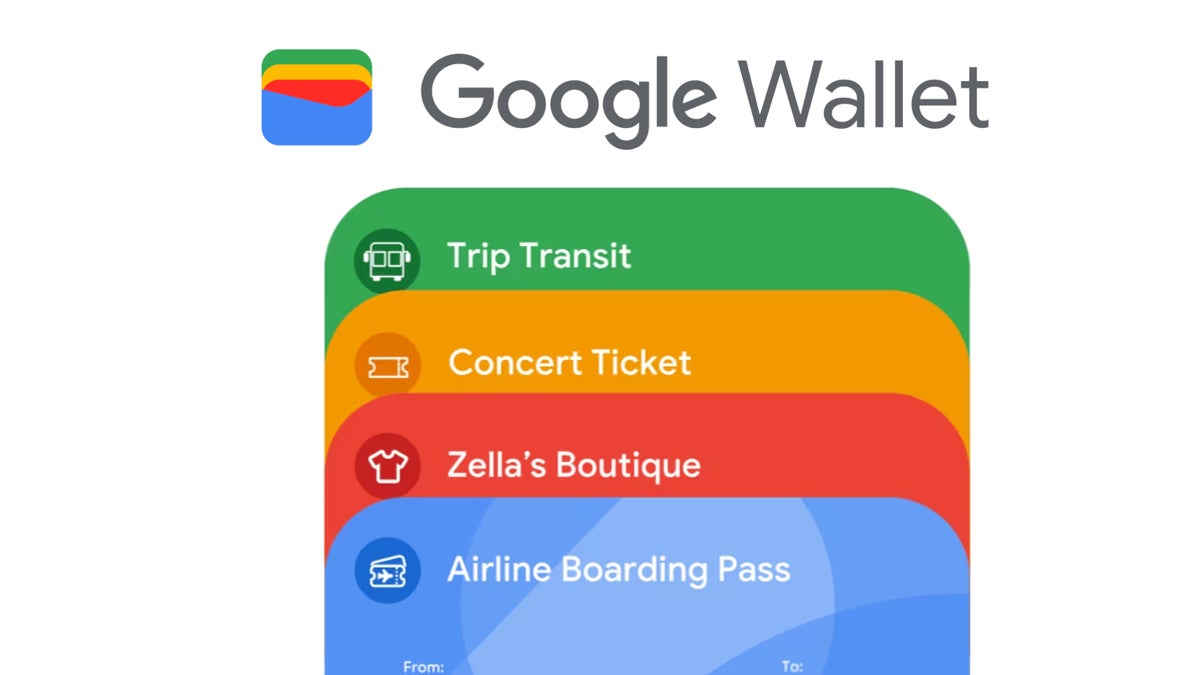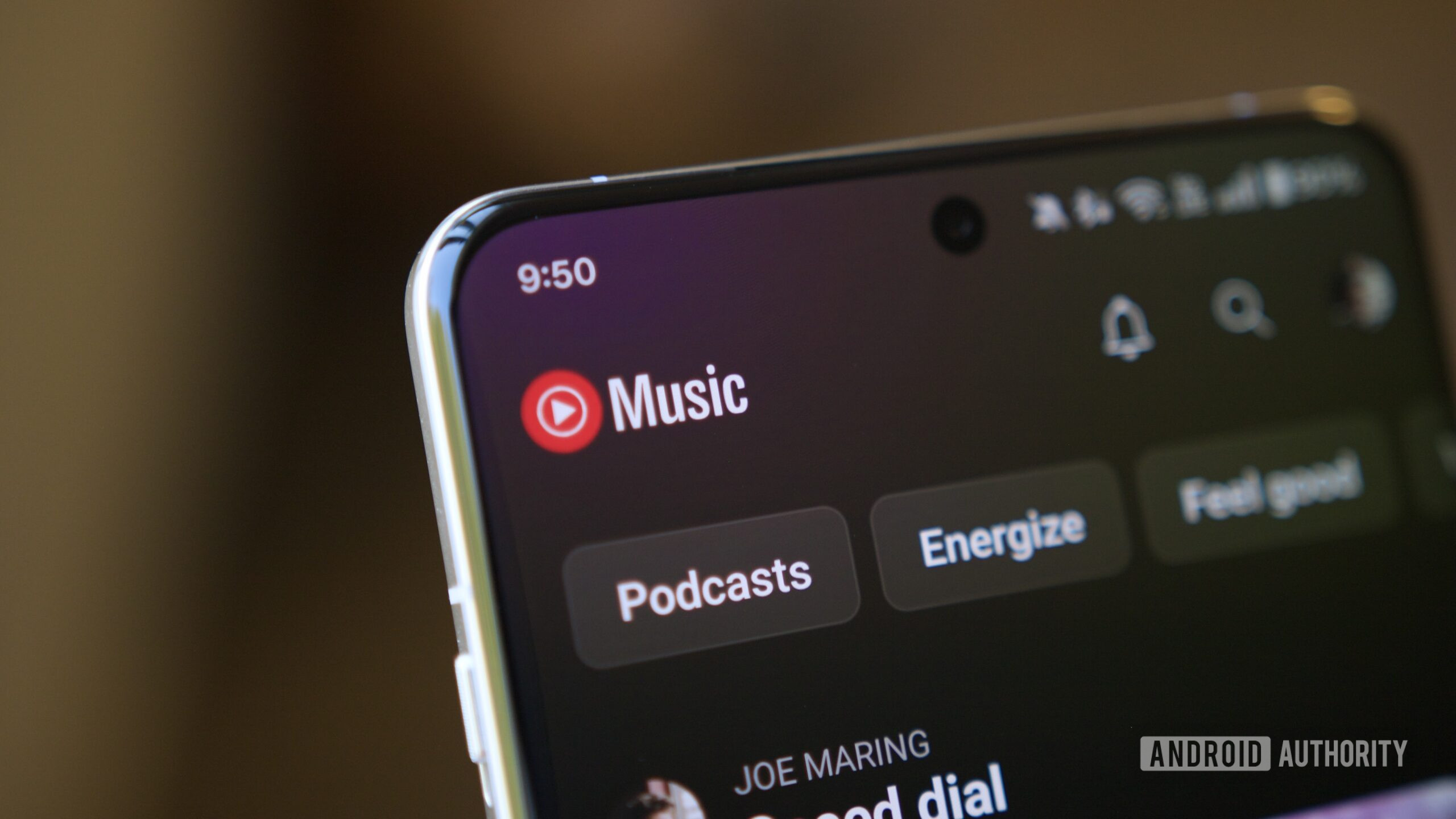For many businesses, finding new leads might be the most impactful way to use AI. Sure, it can help us organize and operationalize processes. But the real payback comes when it’s aimed at bringing in high-intent buyers.
Not at an aspirational, 10,000-foot level—but on the ground, in everyday use cases that consistently deliver new leads.
I’ve gathered eight such AI lead-generation strategies here, complete with examples and processes directly from the marketing pros who use them.
Here are five ways to generate new leads using AI, along with real-world ideas and examples from marketing pros to help get you started.
Understanding your target audience is critical for lead generation. It’s also really time-consuming. There are so many sources of high-value customer intel—like social media feeds, news reports, and online forums—that it’s hard for a human to sort through them all.
AI tools are extremely handy here. You can prompt your AI to dig through the far reaches of the internet to find specific insights about your target customers. Then, use that information to target ads more precisely, create more relevant lead-gen content, and more.
Abbie said she uses these insights and quotes to guide new blog posts, lead generation assets, and FAQ copy.
Another approach is to analyze a specific, long forum discussion. Say you market calendar management software. You could ask an AI like Google Gemini to review a large Reddit thread (e.g., 253 responses) and answer:
Scan the feedback and use it to shape your lead-gen copy around the likes, dislikes, and pain points mentioned.
Before prompting an AI tool, be clear about the specific lead-gen challenge you’re solving. Want better ad targeting? Ask for details about the people posting, such as their industry, location, use case, etc.
2. Supercharge inbound lead generation on social media
Inbound lead generation is a fantastic strategy to supplement your paid ads efforts on social media. Social media content, like educational posts, goes out into the digital world and attracts people who are likely to use what you sell.
So, how do you have the time to post enough on social media to please algorithms and attract leads?
AI platforms, like generative copywriting tools and image creators, accelerate content creation for social. When used as assistants, they help you get in front of more people while keeping your brand voice intact.
“Our link-building agency runs entirely on inbound,” Andriy Zapisotskyi, founder of GrowthMate, said. “It’s powered by referrals and consistent, strategic social selling on LinkedIn. AI helps us do this faster, better, and at scale, without losing the personal touch.”
One example Andiry gave was using AI to help write new social media posts based on what he and others have written in the past. “I use Scripe, an AI tool that analyzes my tone, past posts, and thought leaders I follow, to generate authentic hooks and outlines,” he explained. “It also taps into our internal library of case studies and insights, cutting content creation time in half.”
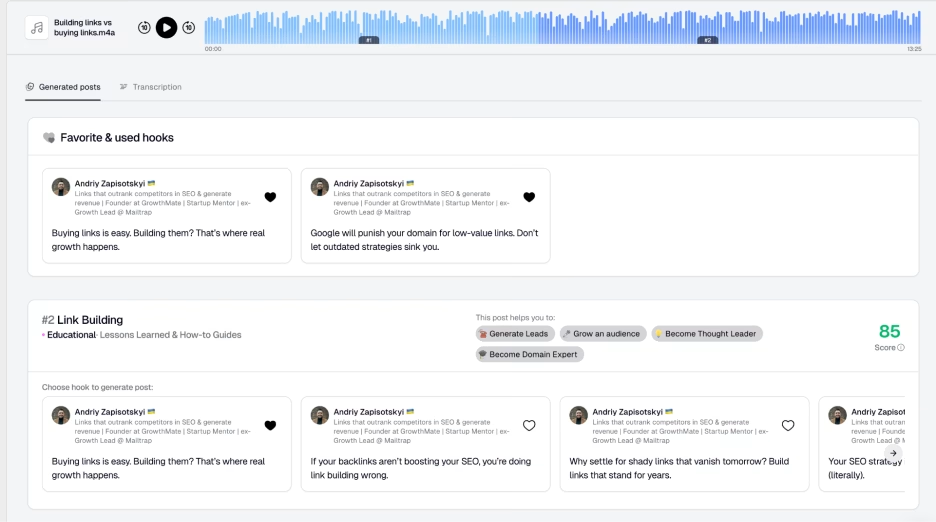
I especially love the bit about tapping into case studies. Good case studies are absolute gold mines for lead gen because they highlight how your solutions have helped people in the past. Using AI to find contextually appropriate results from dozens of them to bake into a blog or social media post is next-level genius.
Coming up with new content ideas is another bottleneck that AI solves. Andriy uses Topic-GPT, a custom GPT that returns 20 categorized ideas based on a given topic.
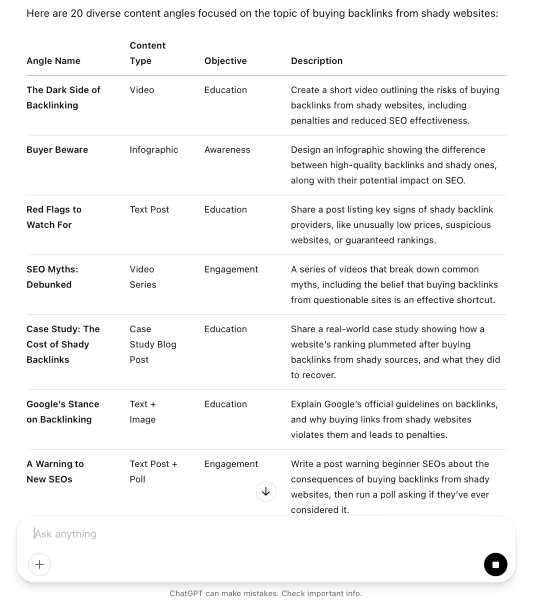

Notice how it also categorizes each idea by objective and content type. That’s helpful when you’re organizing your content calendar.
Almost any generative AI tool can help you brainstorm and create engaging content. Just feed it examples of your favorite posts and top industry voices to ensure it stays on-brand and goal-oriented.
3. Personalize lead-generation assets
Most marketers (89% in one study) see a positive ROI from personalization. That makes sense—personalized lead-gen assets like marketing emails or pop-ups feel more relevant to the person you’re trying to convert.
We’ve covered how AI can surface customer insights. It can also help create multiple variations of marketing assets for different audience segments quickly.
Bhavesh Gabani, co-founder at DesignWiz, used the AI flyer generator to launch a targeted campaign for a home cleaning service. The goal? Promote a “first clean free” offer across different neighborhoods.
“We recently used the AI flyer generator from DesignWiz to launch a targeted, lead-gen campaign for a home cleaning service,” Bhavesh said. “The goal was to promote a limited-time ‘first clean free’ offer and capture qualified leads in different neighborhoods.”
The tricky part is that the cleaning business needed multiple versions of the flyer quickly. Each one had to promote a service for different property types like apartments, townhomes, or large, single-family residences. That meant using different copy and images to highlight a variety of pain points and be more relevant for each segment.
Using AI made this possible without stretching the business’s budget or bandwidth.


They even added a QR code that linked to a short intake form customers could use to schedule a free estimate.
Physical copies of the flyers made their way to each neighborhood, and digital versions landed in Facebook community groups. “The result was a strong response, with a noticeable uptick in inquiries and conversions,” Bhavesh said.
Audience segmentation and marketing personalization are especially tough for local businesses that often don’t keep a full-time marketer on staff. This use case for AI is a game changer that’ll let local service providers make their lead generation efforts more effective.
You can use similar tactics to personalize emails and texts with AI tools. There are even lead management tools that use AI to automatically segment your audience and nurture them based on where they are in the funnel, allowing you to follow up quickly and reach prospects at the exact time they’re ready to convert.
4. Use AI to create lead-generating free tools
Offering something valuable is key to successful lead generation. That’s why discounts or free resources are so effective at it.
Free online tools are one of the best options for delivering value. People love them and will often use them over and over. One of the newer ways to use AI for lead generation is to build free tools without learning to write code.
Deian Isac, founder of Service Provider Pro, has used this strategy prolifically with great results. He built 16 free tools for his website without help from his dev team using an AI assistant.
Once you have some free tools ready to go, you can use them in several ways to generate leads. Deian placed some of his on an SEO-friendly “Free Tools” page that’ll attract leads through search.
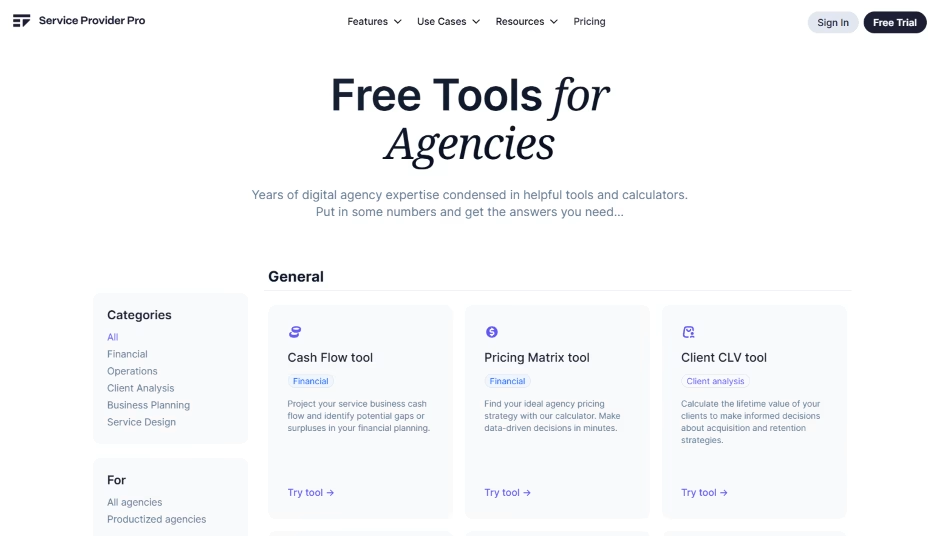

Source
AI makes building these free tools really easy. That means you can spin one up for a very specific use, like adding to a blog post or as a way to refresh and add value to older content.
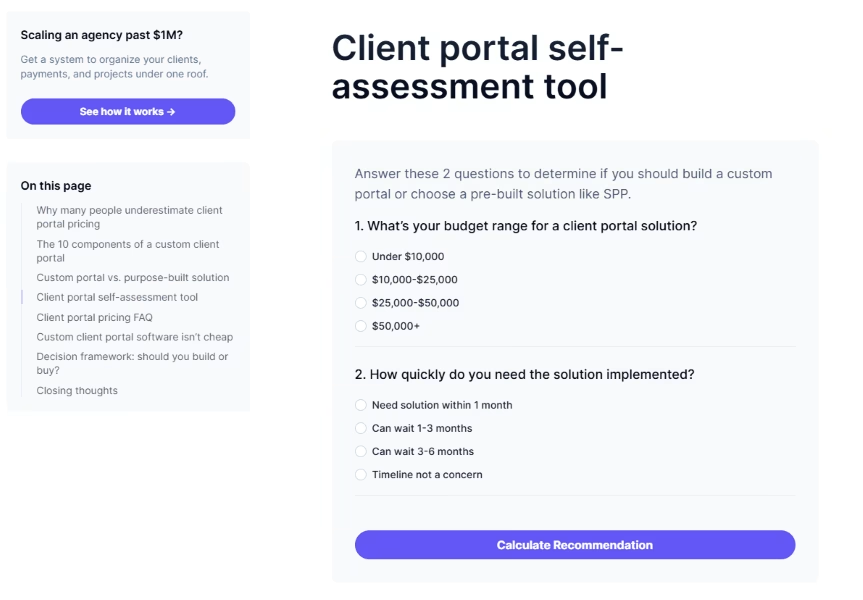

Source
“[Adding tools to blog posts] not only provides value to the reader, it actively helps them find the right reporting tool,” he added. “Plus, it keeps them longer on the page with this interactive widget.”
Another option is to use your AI-generated free tools as a lead magnet. When a website visitor clicks on a relevant page, they’ll see a pop-up asking for their email address (or some other contact information) to get the tool. This tactic does double duty as a lead qualifier because most people who want the tool will be in your target market.
The sky’s the limit on what free tool you create. Free quote estimators, product-use calculators, and self-assessment tools are just scratching the surface. Whatever your customer will find valuable is on the table.
5. Install a chatbot AI agent
Chatbots act like little customer service specialists and salespeople that work around the clock to convert website visitors into leads. They’re not new, but they have evolved way beyond simply answering FAQs.
Now, a modern AI agent can engage in conversation with a website visitor, offer contextually accurate responses, and learn from interactions to improve future results. If you haven’t seen what this new breed of AI agents can do, it might be a good time to check them out.
Hapreet Munjal, founder of LoudGrowth, shared a compelling example of how effective modern chatbots can be. “For one of our B2B clients, we developed an AI chatbot to personalize each customer’s [website] experience,” he said. “The chatbot does a predictive analysis by analyzing how a person interacts with the website and the kind of pages and content they look for.”
The agent asks questions to learn even more about each visitor. Then it provides solutions based on what it learns. Harpreet says that just deploying the bot bumped the client’s MQLs up by around 40%.
AI agents sound a little far-fetched for a small business, but they’ve become a lot more accessible. Dash by LocaliQ’s AI agent, for example, instantly replies to incoming text messages in natural language and guides people through the sales process.


3 more AI lead generation ideas from Reddit and LinkedIn
It’s no surprise that marketers are talking about how to use AI to generate more leads in online forums. Here are a few of the strategies they shared.
6. Identify new ways to target your customers
AI excels at identifying patterns and connections. Use it to find new leads who are very similar to your current best customers (and therefore more likely to buy).
Levente Kótka, CEO and founder of InnoBotZ, briefly mentioned this idea in a LinkedIn post. His method is to have AI review data from your customer CRM to find not-so-obvious similarities they share. Then, you can apply those characteristics to refine your targeting.
Try applying the same logic to other types of customer and website visitor data. For example, AI can track how people interact with your website before they decide to buy. As it identifies patterns that suggest buying intent, it can trigger perfectly timed outreach with a personalized offer to close the deal
7. Build custom GPTs for a variety of content creation jobs
Build custom GPTs for your unique lead generation needs
We talked about how you can use AI to accelerate lead-gen content creation. But sometimes your unique needs can’t be met with the generic version of an AI tool. That’s where customer GPTs come in.
A custom GPT is basically like your own personal ChatGPT, designed specifically for your business and use case. It knows how to write for your brand and situation because you train it with information like your FAQs, policies, product pages, and so on.
“I find that AI can get really flummoxed if you give it too many seemingly related tasks,” Curt Woodward, content director at ZoomInfo, recently posted on LinkedIn. “It starts crossing the streams and can’t give you the right format. So, I just keep the work in chunks and treat the GPTs we train on specific output formats as limited-purpose bots.”
You can create a custom GPT to do almost any job. Here are a few examples Curt shared:
- Customer Story Bot: Generates a first draft of a case study from a customer interview.
- Case Study Wrapup Wranger: Creates the first draft of a blog post or ebook based on several case studies from the same use case.
- Executive Voice: a content creation GPT that’s trained using top executives’ interview transcripts and published writings to quickly turn around new material in their voices.
Custom GPTs are surprisingly easy to create. Navigate to OpenAI (you’ll need to log in), click “Explore GPTs,” and hit the “Create” button. Then follow the step-by-step instructions from the creation wizard.
8. Use predictive analytics to get more leads through email
No matter how far along marketing tech goes, email holds its place as one of the best lead generation and nurturing channels available. To nudge up your email marketing success, try using AI predictive analytics.
Predictive analytics AI constantly monitors how people interact with your emails. Then, it makes suggestions based on that behavior to help improve your results.
One Reddit user posted how they used predictive analytics to boost their open rates by 35% and revenue from email campaigns by 50%.
In the example, they used AI to predict two things: the best time to send an email and which subscribers were most likely to engage with it.
That second point is really interesting. It’s like dynamically segmenting your audience with each email send. Each message is only sent to people who will likely enjoy it. That’ll not only boost open rates, but it could also reduce unsubscribes and keep your emails out of spam folders.
Combine that with the hyper-personalization we mentioned before, and you’ll see how AI can transform your email marketing strategy.
AI is the lead-generation equalizer
AI lets even a tiny marketing team do things that were once solely accessible to big brands with deep pockets. A marketing team of one, for example, could never before really personalize hundreds of outreach emails using up-to-the-minute industry insights.
The lead-gen tips on this list are great examples of this. They show that with a little creativity, an AI tool can be a huge force multiplier, increasing lead gen many times over without overtaxing a small team. If you’d like to get a little deeper into the discussion, contact us. We’ll show you how we use AI to speed up lead generation from just about every digital marketing channel.









